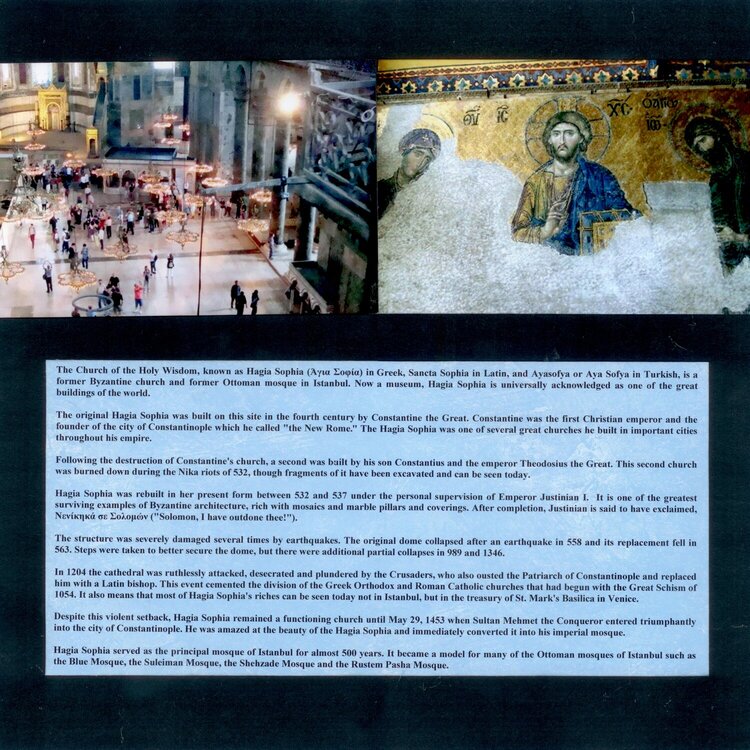Join us today at 9:00am PT / 12:00pm ET | Details Here.


 Give a Cheer
Give a Cheer
The Church of the Holy Wisdom, known as Hagia Sophia (Sorry, the Green letters won't transfer here) in Greek, Sancta Sophia in Latin, and Ayasofya or Aya Sofya in Turkish, is a former Byzantine church and former Ottoman mosque in Istanbul. Now a museum, Hagia Sophia is universally acknowledged as one of the great buildings of the world.
The original Hagia Sophia was built on this site in the fourth century by Constantine the Great. Constantine was the first Christian emperor and the founder of the city of Constantinople which he called "the New Rome." The Hagia Sophia was one of several great churches he built in important cities throughout his empire.
Following the destruction of Constantine's church, a second was built by his son Constantius and the emperor Theodosius the Great. This second church was burned down during the Nika riots of 532, though fragments of it have been excavated and can be seen today.
Hagia Sophia was rebuilt in her present form between 532 and 537 under the personal supervision of Emperor Justinian I. It is one of the greatest surviving examples of Byzantine architecture, rich with mosaics and marble pillars and coverings. After completion, Justinian is said to have exclaimed, (More Greek) ("Solomon, I have outdone thee!").
The structure was severely damaged several times by earthquakes. The original dome collapsed after an earthquake in 558 and its replacement fell in 563. Steps were taken to better secure the dome, but there were additional partial collapses in 989 and 1346.
In 1204 the cathedral was ruthlessly attacked, desecrated and plundered by the Crusaders, who also ousted the Patriarch of Constantinople and replaced him with a Latin bishop. This event cemented the division of the Greek Orthodox and Roman Catholic churches that had begun with the Great Schism of 1054. It also means that most of Hagia Sophia's riches can be seen today not in Istanbul, but in the treasury of St. Mark's Basilica in Venice.
Despite this violent setback, Hagia Sophia remained a functioning church until May 29, 1453 when Sultan Mehmet the Conqueror entered triumphantly into the city of Constantinople. He was amazed at the beauty of the Hagia Sophia and immediately converted it into his imperial mosque.
Hagia Sophia served as the principal mosque of Istanbul for almost 500 years. It became a model for many of the Ottoman mosques of Istanbul such as the Blue Mosque, the Suleiman Mosque, the Shehzade Mosque and the Rustem Pasha Mosque.
No products have been added to this project.
Thanks for spreading positivity!
January 06, 2015
December 31, 2014
December 31, 2014
December 30, 2014
December 30, 2014
December 30, 2014
December 30, 2014
December 29, 2014
December 29, 2014
December 29, 2014
December 29, 2014